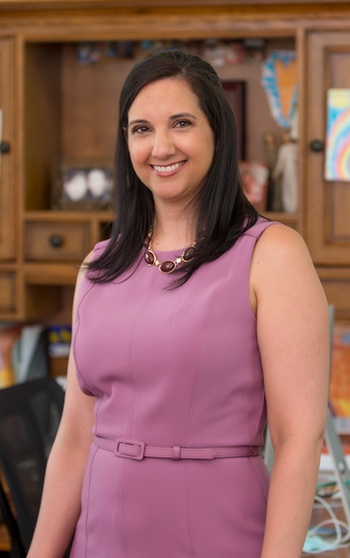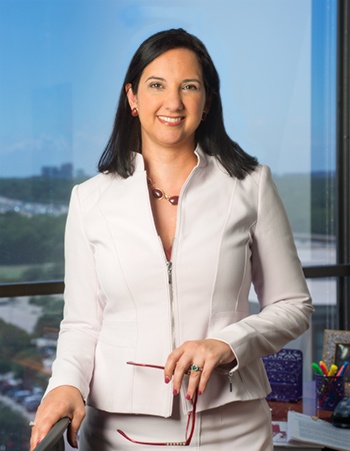Composing financial solutions for clients’ ‘personal economies’
Composing financial solutions for clients’ ‘personal economies’

Treta Sellers • Dallas, TX
Personal Economics Group
Read full biography below
Proactive Advisor Magazine: Treta, talk about your personal philosophy and goals as a financial advisor.
I believe the best way to establish a solid, successful business relationship with my clients is to genuinely be interested in their lives, goals, accomplishments, and dreams. As I reflect on my client base, I realize these people are my friends first and my clients second. I approach my clients’ financial situations holistically. My goal is to work with clients to make decisions that will help them become more financially successful, both now and in planning for their future goals.
Two areas that I particularly focus on are working with women business owners and with couples or individuals facing the challenges of retirement planning. Women business owners tend to be extremely hardworking and passionate about their businesses, and they are experts in their field. Since that can leave less time to explore solid financial-planning options on their own, I think I can add value for them in their planning for growth, protection for their business, and also their own financial-planning issues.
I also try to help my clients understand that preparing for retirement is like climbing a mountain. A person can accumulate what they think is enough for a secure retirement—thus reaching the summit—only to find that getting down the mountain—protecting their lifestyle—is equally, if not more, important. We employ a rigorous planning process to help clients identify the issues that are specific to their retirement needs and then work with them to implement suitable product and service solutions.
I am passionate about my role as a woman in the financial-services industry. My position requires long hours and dedication, but it also offers great flexibility and the ability to earn according to my efforts and success. I love helping others, and I also love having the opportunity for a meaningful and fulfilling career without sacrificing my family life.
What is the significance of your firm’s name, Personal Economics Group?
 One of the main reasons I joined this firm was the overall philosophy of the Personal Economics Group. The firm is focused on educating clients about how the pieces of their personal economies need to work together holistically. It is a nonjudgmental and economics-based approach, taking a practical and hands-on look at the issues that clients present and then working closely with them to develop solutions they can readily implement.
One of the main reasons I joined this firm was the overall philosophy of the Personal Economics Group. The firm is focused on educating clients about how the pieces of their personal economies need to work together holistically. It is a nonjudgmental and economics-based approach, taking a practical and hands-on look at the issues that clients present and then working closely with them to develop solutions they can readily implement.
The company is based on the principle that a client’s education and understanding of their current financial situation is vital to making prudent decisions concerning their future financial condition. Before deciding where to put their money to work, clients need to understand how their money is currently working and how it could work for them. We do not have preconceived notions of what a client’s financial plan should look like—it is based on their situation and goals.
We add value by helping them fully understand their situation, ask what-if questions, and help them craft strategies using a full range of financial solutions. I think a lot of financial advisors in our industry tend to be oriented toward either insurance solutions or investment solutions. We want to have those two pieces work together, with an emphasis on risk management for both. It is rare that a client comes to us with just one financial or life issue. It is usually a combination of many issues, such as retirement-income planning, college funding, elder-care funding, long-term-care funding, legacy planning, and so forth. The challenge is in asking the important and sometimes uncomfortable questions, setting priorities, and helping clients make informed choices regarding their full set of financial issues.
I think where we offer the most value to clients is helping them recognize they have many choices. For example, in retirement they may want to continue with their current lifestyle or they might want to move to a new area, or downsize, or live on a more limited budget. We can help them explore all of those options and craft a financial path that creates choices, not limiting them to “have-to” decisions for retirement. It is a matter of planning carefully for it in advance and helping clients understand the trade-offs involved as they strive to make the rest of their lives fulfilling on a personal and financial level.
Talk about your planning process.
When I am first meeting with a client, I want to find out what they are looking to accomplish. What are their dreams? What are their goals? And what is their time line? Before I even get to that, I want to get to know them on a personal level as much as possible. What is their family history? Their current family situation? What is or was their career like? What do they enjoy doing for fun or for vacations, as a hobby, or in terms of civic or charitable activities? I want them to get to know me on a personal level as well, since it helps establish common ground.
From there we will get into collecting data. I use a comprehensive fact finder to help identify their current assets and liabilities, cash flow and budgeting, insurance coverages, potential sources of income, and whether they have some sort of legacy planning in place. I will also take them through a quantitative methodology for identifying their risk tolerance. When dealing with couples, it is very important for both spouses to complete this process, as there can often be a wide gap in how spouses view risk.
“I am passionate about my role as a woman in the financial-services industry.”
Our firm uses very robust financial-planning software. Going through the planning process, we can help clients understand why holistic planning can make a difference, identify their goals and objectives, look at different financial scenarios, and explain the differences between accumulation and distribution strategies during their lifetime. We will discuss objectives and priorities and then look to identify the strategies that will help them achieve those goals. We will construct an implementation time line, proceed with the implementation of strategies, and then meet regularly to review progress toward their objectives. Since this is a lifetime planning process, it should have the ability to remain fluid if life or financial circumstances change or if clients want to revise their goals.
Within this planning construct, what is your broad investment philosophy?
For individuals or couples planning for retirement, the broad goals are to find ways to leverage their assets so they can potentially grow and be distributed efficiently over the course of a lifetime, help fund their legacy objectives, and work with other income streams to create a paycheck for retirement. We educate clients on how rates of return work in an investment account. We also discuss the difference between actual sequential returns and average returns and how that might affect their portfolio. To that point, the sequence of returns is a very real risk for retirees, so one of my main objectives is to help mitigate overall portfolio volatility. I am also concerned with managing fee exposure and tax efficiency, so our investment planning addresses both of those factors where we can.
 Our investment planning starts with clients’ quantified risk assessment, their time line, and their overall financial-planning goals. We identify portfolio allocations and specific strategies in line with these factors, especially the client’s risk profile. I personally favor using the services of professional money-management firms that are dedicated to creating, researching, and managing investment strategies. One firm I work with places a high priority on risk management throughout its many strategies. I also like that they use a scientific and algorithm-based approach, where investment decisions are rules-based and strategies can adapt to changes in market conditions.
Our investment planning starts with clients’ quantified risk assessment, their time line, and their overall financial-planning goals. We identify portfolio allocations and specific strategies in line with these factors, especially the client’s risk profile. I personally favor using the services of professional money-management firms that are dedicated to creating, researching, and managing investment strategies. One firm I work with places a high priority on risk management throughout its many strategies. I also like that they use a scientific and algorithm-based approach, where investment decisions are rules-based and strategies can adapt to changes in market conditions.
I tell clients that it does little good to earn 30% in their portfolio one year if the next year they are going to lose 20%. The math might seem good on an averaged basis, but that is not the way the real math works out. Again, this is all part of our educational process. I am more interested in smoothing out returns and volatility over long periods and avoiding damaging drawdowns as much as possible. That is where the risk-management tools of our managers’ strategies play such an important role. We are not aiming for the highest returns, but for competitive returns, with the goal of maintaining them over time to help clients achieve their retirement-funding goals.
I do not like to position a client’s investment portfolio as either passive or active; to my mind, it is a strategic managed account, with a blend of different strategies that work together to attempt to achieve consistent returns, manage risk, adapt to market conditions, and provide diversification. Our managers have done a lot of research developing their specific strategies and understand the mathematical underpinnings of enhancing the probabilities for their strategies’ success. There are no guarantees, of course, but this investment approach aligns well with our overall planning philosophy, and I believe it serves clients well as they plan for their retirement future.

Sharing broad principles that help guide retirement planning
Treta Sellers of Personal Economics Group in Dallas, Texas, places education at the forefront of her relationships with clients. She advocates for a holistic approach to financial and retirement planning and shares the following broad principles with clients at the beginning of the process, providing detailed explanations of each area:
- Understand the differences between wealth accumulation and retirement-income distribution.
- Take a long-term view of retirement, employing efficiencies spread out over many years.
- Be conservative in planning and return assumptions.
- Use an integrated planning strategy that manages risk across many components.
- Explore how insurance, fixed-income products, and investments can play synergistic roles.
- Use economic principles in approaching a retirement plan and allocating resources.
Recent Posts:
 Treta Sellers is a financial advisor with Personal Economics Group (PEG), located in Dallas, Texas. PEG offers clients a comprehensive strategic approach to addressing a variety of financial issues, including wealth management, personal and business risk management, and retirement-income planning.
Treta Sellers is a financial advisor with Personal Economics Group (PEG), located in Dallas, Texas. PEG offers clients a comprehensive strategic approach to addressing a variety of financial issues, including wealth management, personal and business risk management, and retirement-income planning.
Ms. Sellers has worked in the financial-services industry for more than 15 years, holding several positions in the areas of retail and commercial banking, asset-management services, retirement planning, wealth management, and financial advising. She says her varied and deep experience “provides an excellent background for finding comprehensive financial solutions for clients.” She has been with Personal Economics Group since 2016.
A fine arts graduate of Texas State University, Ms. Sellers majored in vocal and music performance. She has performed with the Dallas Symphony Chorus for five seasons. She says her performance training has taught her “how to be comfortable in front of large groups of people and properly prepare for events—and how to be heard and keep people’s attention.”
Ms. Sellers and her husband reside in the Dallas area and have two children. She enjoys spending time with the family, singing, scuba diving, and baking. Ms. Sellers is active in the Dallas branch of the National Association of Women Business Owners (NAWBO) and was a former board member. She has recently become a volunteer financial coach with WiNGS for Women and Families in Dallas, which assists low- to middle-income families.
Disclosure: Registered Representative and Investment Advisor Representative of and securities offered through OneAmerica Securities, Inc., a Registered Investment Advisor, Member FINRA, SIPC. Personal Economics Group is not an affiliate of OneAmerica Securities and is not a broker dealer or Registered Investment Advisor. Provided content is for overview and informational purposes only and is not intended and should not be relied upon as individualized tax, legal, fiduciary, or investment advice. Investing involves risk which includes potential loss of principal. The use of asset allocation or diversification does not assure a profit or guarantee against a loss.
Photography by Robert Hart

